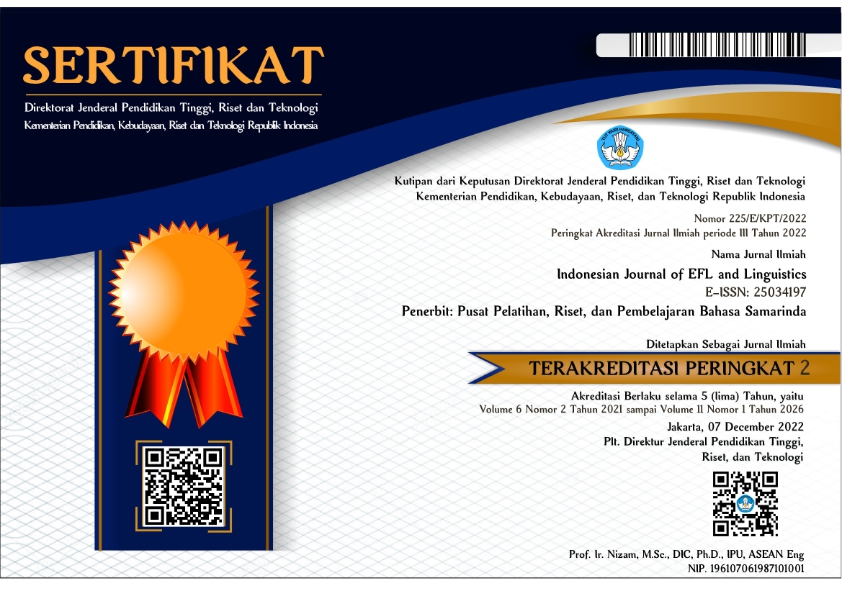The Comparison of Satirical Jokes in the Reels of @Podcastkeselaje and The Daily Show with Trevor Noah
Abstract
Despite the rise of social media platforms such as Instagram, satire remains an effective way to discuss and criticize current issues and states of affairs without offending communities. Hence, this research examines the satirical jokes found in the @podcastkeselaje Instagram account and The Daily Show With Trevor Noah in order to discuss social phenomenon that exist between different states. The objectives of this study are to classify the types of satire, describe the way of the satirical jokes are delivered in the reel video and The Daily Show, and explain the comparison of satirical jokes found between Indonesian and American culture. The data was collected from 15 reel videos of @podcastkeselaje official Instagram account with a total of 67 utterances, compared to 4 episodes of Trevor Noah’s Show with a total of 11 utterances. This qualitative study employs Critical Discourse Analysis (CDA) by Fairclough as the approach and Abrams and Harpham’s concept of satire. Based on the results of the study, Horatian satire (28,2%), Juvenalian satire (20,6%), and Menippean satire (51,2%) are the most frequently found in the reels video. The satirical jokes found in the reel videos were delivered in a direct way, either by serving humor or insulting the target harshly and indirectly expressing the satire to the target. According to the findings, the comparison of Indonesian and American satire is clearly depicted by the similarities in social, political, and racism issues due to similar social backgrounds; if Indonesia consisted of various tribes, America is consisted of various ethnicities. Both of the nations adhere to a democratic system which refers to the implementation of Human Rights no matter what their races, they are totally different in cultural cases related to Eastern and Western norms and values. Therefore, the background of a culture impacts the realization of the satire.
References
Ahn, J., Son, H., & Chung, A. D. (2021). Understanding public engagement on twitter using topic modeling: The 2019 Ridgecrest earthquake case. International Journal of Information Management Data Insights, 1(2), 100033. https://doi.org/10.1016/j.jjimei.2021.100033
Baumgartner, J., & Morris, J. S. (2007). Laughing Matters: Humor and American Politics in the Media Age. Routledge.
Coyne, S. M., Rogers, A. A., Zurcher, J. D., Stockdale, L., & Booth, M. (2020). Does time spent using social media impact mental health?: An eight year longitudinal study. Computers in Human Behavior, 104, 106160. https://doi.org/10.1016/j.chb.2019.106160
Creswell, J. W. & Clark. 2014. Designing and Conducting Mixed Methods Research. Sage Publications
Dijk, T. V. A. (2011). Discourse Studies: A Multidisciplinary Introduction (Second). SAGE Publications Ltd.
Dwivedi, Y. K., Mäntymäki, M., Ravishankar, M., Janssen, M., Clement, M., Slade, E. L., Rana, N. P., Al-Sharhan, S., & Simintiras, A. C. (Eds.). (2016). Social Media: The Good, the Bad, and the Ugly. Lecture Notes in Computer Science. https://doi.org/10.1007/978-3-319-45234-0
Ezell, S. K. (2016). Humor and Satire on Contemporary Television: Animation and the American Joke (The Cultural Politics of Media and Popular Culture) (1st ed.). Routledge
Fairclough, N. (1992). Discourse and Social Change. Polity Press
Frye, N., & Damrosch, D. (2020). Anatomy of Criticism: Four Essays (Princeton Classics, 69) (2nd ed.). Princeton University Press.
Gilbert, C. J. (2015). If This Statue Could Talk: Statuary Satire in the Pasquinade Tradition. Rhetoric and Public Affairs, 18(1), 79–112. https://doi.org/10.14321/rhetpublaffa.18.1.0079
Holbert, R. L., Hmielowski, J., Jain, P., Lather, J., & Morey, A. (2011). Adding Nuance to the Study of Political Humor Effects: Experimental Research on Juvenalian Satire Versus Horatian Satire. American Behavioral Scientist, 55(3), 187–211. https://doi.org/10.1177/0002764210392156
Kar, A. K. (2020). What Affects Usage Satisfaction in Mobile Payments? Modelling User Generated Content to Develop the “Digital Service Usage Satisfaction Model.†Information Systems Frontiers, 23(5), 1341–1361. https://doi.org/10.1007/s10796-020-10045-0
Kavasoğlu, R., & Koca, C. (2021). Gendered Body of Turkish Bikini Fitness Athletes on Instagram. Communication &Amp; Sport, 10(4), 685–707. https://doi.org/10.1177/2167479520961370
Kramsch, C. (1995). The cultural component of language teaching. Language, Culture and Curriculum, 8(2), 83–92. https://doi.org/10.1080/07908319509525192
Lado. Robert. 1962. Linguistics Across Culture. The University of Michigan Press.
Mackson, S. B., Brochu, P. M., & Schneider, B. A. (2019). Instagram: Friend or foe? The application’s association with psychological well-being. New Media &Amp; Society, 21(10), 2160–2182. https://doi.org/10.1177/1461444819840021
Nasir, N. S., & Hand, V. M. (2006). Exploring Sociocultural Perspectives on Race, Culture, and Learning. Review of Educational Research, 76(4), 449–475. https://doi.org/10.3102/00346543076004449
Oring, E. (1984). Jokes and Their Relation to Sigmund Freud. Western Folklore, 43(1), 37. https://doi.org/10.2307/1499428
Papana, Ramon. (2012). “Kiat Tahap Awal Belajar Stand Up Comedy Indonesia: Kitab Suciâ€. Jakarta: Trans Media
Prasetyono, Dwi Sunar. (2011). Buku Lengkap Majas dan 3000 Peribahasa. Diva Press
Rogers, R. (2004). An Introduction to Critical Discourse Analysis in Education. Lawrence Erlbaum Associates, Inc.
Sharma, A., Sanghvi, K., & Churi, P. (2022). The impact of Instagram on young Adult’s social comparison, colourism and mental health: Indian perspective. International Journal of Information Management Data Insights, 2(1), 100057. https://doi.org/10.1016/j.jjimei.2022.100057
Sobur, A. (2013). Psikologi Umum. Pustaka Setia.
Van Eeden, A. (2020). Tama Leaver, Tim Highfield, and Crystal Abidin, Instagram: Visual social media cultures. Mobile Media &Amp; Communication, 8(3), 439–440. https://doi.org/10.1177/2050157920928534b
Copyright (c) 2023 Indonesian Journal of EFL and Linguistics

This work is licensed under a Creative Commons Attribution-NonCommercial-ShareAlike 4.0 International License.




